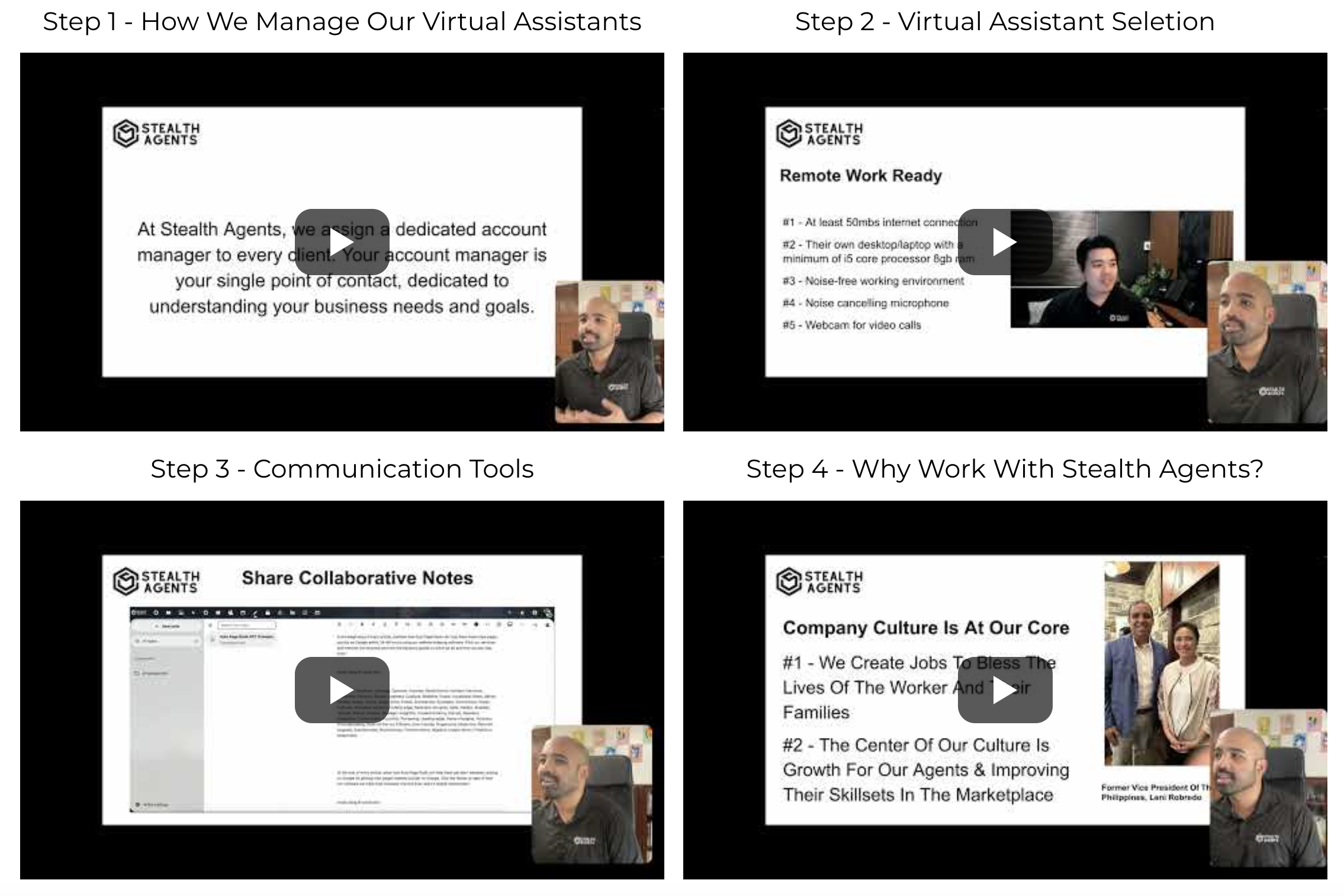The debate on remote virtual assistant vs on-site assistant is crucial for businesses to optimize their operations.
Studies suggest hiring a virtual assistant can reduce operational expenses by up to 78%, offering a cost-effective alternative to on-site staff.
When you hire a virtual assistant, you not only embrace flexibility but also enjoy enhanced productivity, as remote workers have been shown to increase efficiency by up to 35%.
Understanding virtual assistant pricing is essential for businesses looking to balance quality and affordability in their staffing solutions.
Stealth Agents can help you navigate this decision by offering a free discussion to tailor your preferences and find the ideal virtual assistant for your needs.
What are the Major Differences Between Remote Virtual Assistants and On-Site Assistants?
-
Cost Efficiency:
One of the most significant differences between remote virtual assistants vs on-site assistants is the overall cost.
Remote virtual assistants typically offer more affordable solutions as they eliminate expenses related to office space, utilities, and other overhead costs.
Businesses can save even more by hiring virtual assistants from regions with lower living expenses, making it a cost-effective choice.
In contrast, on-site assistants require a physical presence, necessitating additional expenditures.
Therefore, opting for remote assistance can result in substantial budgetary advantages.
*advertisement*
Tired & Overwhelmed With Administrative Tasks?
Hire A Top 1% Virtual Assistant From Stealth Agents!

Sign Up Below & Hire A Top 1% Virtual Assistant
Rated 4.7 Stars Serving Over 2,000+ Customers.
Hire Top 1% Virtual Assistants For $10-$15 Per Hour
Ask About Our 14 Day Trial!
*advertisement*
-
Flexibility in Operations:
When considering remote virtual assistants vs on-site assistants, flexibility is a key factor that sets them apart.
Remote virtual assistants can work across different time zones and schedules, providing businesses with around-the-clock support.
This flexibility allows companies to cater to international clients or manage workloads that do not fit the traditional 9-to-5 schedule.
Conversely, on-site assistants are typically bound by fixed office hours, which limit the adaptability of their services.
Businesses seeking a more versatile workforce should consider the benefits of remote arrangements.
-
Communication Dynamics:
Another area of differentiation is the communication dynamic between remote virtual assistants vs on-site assistants.
Remote virtual assistants rely heavily on digital communication tools such as emails, video conferencing, and instant messaging, which require precise and concise interaction.
While this can lead to more efficient communication processes, it may also present challenges if not managed properly.
On-site assistants benefit from face-to-face interactions, which can foster stronger relationships but might lack the immediacy of digital responses.
Understanding these dynamics helps businesses choose the right type of assistant.
-
Diverse Skill Sets:
Exploring the skill sets of remote virtual assistants vs on-site assistants uncovers another significant difference.
Due to their exposure to various industries and clients, remote virtual assistants often bring diverse skills, including tech-savvy, multilingual capabilities, and specialized expertise.
This diversity can benefit businesses seeking a broader skill pool without geographic limitations, especially when they choose to hire Filipino virtual assistants known for their strong work ethic and proficiency.
Conversely, on-site assistants may have more focused skill sets tailored to specific company processes and cultures.
Deciding between these options depends on the particular skills required by the business.
-
Productivity Levels:
The productivity of remote virtual assistants vs on-site assistants can vary based on the work environment and management practices.
Remote virtual assistants often operate in settings that minimize distractions, enabling them to focus better on tasks and potentially increasing productivity.
However, the lack of direct supervision might require effective time management and self-discipline from virtual assistants.
On-site assistants can benefit from immediate team collaboration and resource access, enhancing productivity in specific roles.
Companies must weigh these factors when choosing between remote and on-site options.
-
Availability and Accessibility:
Another crucial consideration is the availability of remote virtual assistants vs on-site assistants.
Remote virtual assistants can provide businesses with continuous support, especially when you hire Filipino workers for virtual assistant roles, as they often work across different time zones, ensuring that tasks are handled promptly.
This round-the-clock availability is particularly beneficial for global companies or projects with tight deadlines.
While accessible during office hours, on-site assistants may not offer the same level of availability, particularly outside regular working hours.
Businesses should assess their needs to determine which type of assistant aligns best with their operational demands.
-
Technology Utilization:
The use of technology varies significantly between remote virtual assistants and on-site assistants.
Remote virtual assistants, including those you hire a remote content creators, rely heavily on advanced digital tools and platforms, such as project management and collaboration software, to execute tasks efficiently.
This technological reliance keeps them connected and productive irrespective of location.
Conversely, on-site assistants, due to their physical presence in the office, may need fewer extensive digital tools while still effectively utilizing technology.
Hiring remote content creators offers companies the advantage of prioritizing technological innovation and enhancing remote capabilities, making virtual assistants an appealing choice for businesses focused on efficiency and flexibility.
How Effective Are Remote Virtual Assistants vs On-site Assistants on Businesses?
Evaluating the effectiveness of a remote virtual assistant vs on-site assistant is crucial for businesses aiming to optimize their operations.
Remote virtual assistants can significantly enhance productivity by offering flexible work hours and minimizing office distractions, making them a cost-effective choice.
Businesses that hire Filipino remote workers often benefit from a wide array of skills and adaptability without being limited by geographic constraints.
In contrast, on-site assistants provide the advantage of immediate physical presence, promoting team collaboration and facilitating real-time problem-solving.
The choice between employing a remote virtual assistant vs on-site assistant depends mainly on a company’s specific needs and operational goals.
Understanding these differences allows businesses to strategically align their staffing choices with their objectives.
What are the Benefits of Remote Virtual Assistants vs On-site Assistants?
1. Cost Savings
One of the most significant benefits is cost savings when considering remote virtual assistants vs. on-site assistants.
Remote virtual assistants eliminate the need for physical office space, reducing overhead costs associated with utilities, equipment, and office supplies.
Additionally, businesses can often hire remote talent at more competitive rates due to the broader pool of international candidates.
On-site assistants, while valuable, typically come with higher workplace maintenance and benefits expenses.
This financial efficiency allows businesses to allocate resources to other strategic areas.
2. Flexibility
The flexibility offered by remote virtual assistants vs on-site assistants is a crucial advantage for dynamic businesses.
Remote assistants can work across various time zones, providing continuous support and ensuring tasks are completed regardless of local office hours.
This adaptability is particularly beneficial for global operations or projects with tight deadlines.
On-site assistants, although readily available during regular hours, may offer different schedule flexibility.
Embracing remote work can help businesses remain agile and responsive to changing demands.
3. Access to Diverse Skills
Remote virtual assistants vs on-site assistants provide businesses unparalleled access to diverse skills and expertise.
By hiring remotely, companies can tap into a global talent pool and attract specialized skills that may be outside the domain.
This diversity can drive innovation and help businesses adapt to new challenges and market demands.
On-site assistants may have more concentrated expertise tailored to a specific industry or company culture but might lack the broad range of skills accessible through remote hiring.
Leveraging the global market allows for a more decadent array of talents and perspectives.
4. Enhanced Productivity
The productivity benefits of remote virtual assistants vs on-site assistants lie in minimizing workplace distractions.
Remote assistants often operate in environments tailored to their preferences, fostering greater focus and efficiency.
Furthermore, working outside traditional office hours can lead to faster task completion and enhanced client service.
In contrast, on-site assistants might face more interruptions due to office dynamics and routine disturbances.
Remote work setups often empower assistants to maximize output and contribute more effectively to business goals.
5. Scalability
When weighing remote virtual assistants vs on-site assistants, scalability emerges as a significant advantage for businesses looking to grow.
Remote assistants allow companies to quickly adjust their workforce size in response to fluctuating business demands without the logistical constraints of physical space.
This scalability is ideal for businesses experiencing rapid growth or seasonal shifts in workload.
On-site assistants require more strategic planning concerning office space and resources, which can limit rapid scalability.
Embracing remote work provides the flexibility needed to scale operations smoothly and efficiently.
How to Choose Between a Remote Virtual Assistant vs On-Site Assistant?
Choosing between a remote virtual assistant vs on-site assistant requires a careful assessment of your business’s unique needs and objectives.
If cost-effectiveness is a priority, opting for a remote solution might be advantageous, especially when you decide to hire Filipino remote staff who offer exceptional skills at competitive rates.
Flexibility is another crucial factor; remote assistants can provide support across different time zones, ideal for businesses with international operations or non-standard working hours.
On the other hand, an on-site assistant may be preferable if your business requires immediate physical presence for tasks that demand direct interaction.
Additionally, consider the specific skills needed for your operations; remote assistants can offer diverse expertise due to global access, whereas on-site staff may be more specialized in local industry practices.
The decision between a remote virtual assistant vs on-site assistant should align with your strategic goals and operational demands.
Why Choose Stealth Agents for Remote Virtual Assistant?
Choosing Stealth Agents for your remote virtual assistant needs offers businesses unparalleled expertise and reliability.
Known for their highly skilled professionals, Stealth Agents ensures that tasks are handled efficiently and precisely, boosting productivity and streamlining operations.
The cost-effectiveness of partnering with Stealth Agents is a significant advantage, as businesses gain access to top-tier talent without the overhead costs associated with traditional staffing.
Their commitment to customer satisfaction also means personalized service and support tailored to meet each client’s unique needs.
By selecting Stealth Agents, businesses can focus on growth and innovation and be confident in the quality and consistency of their remote support.
Takeaways
The decision between a remote virtual assistant and an on-site assistant critically depends on your business’s unique needs and strategic goals.
Opting for a virtual assistant offers flexibility, cost savings, and access to a global talent pool, making it an attractive option for many modern businesses.
Stealth Agents is a reliable provider of skilled virtual assistants, ensuring your operations run smoothly and efficiently.
Stealth Agents invites you to call and book a free, tailored discussion tailored to your preferences to explore how a virtual assistant can enhance your business and learn about the various pricing options.
This proactive step can lead to a more agile and cost-effective staffing solution, empowering your business to achieve new heights of success.










